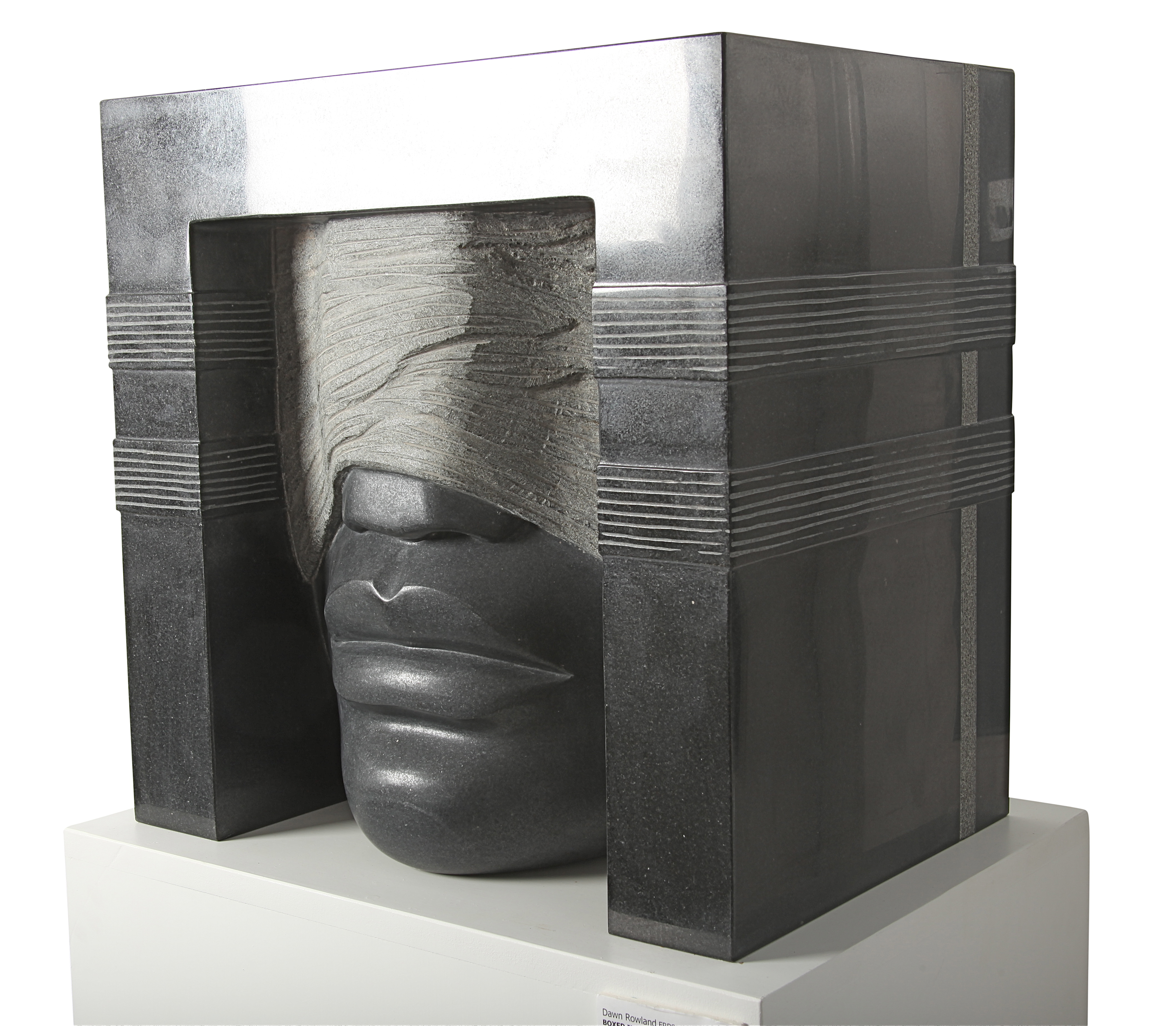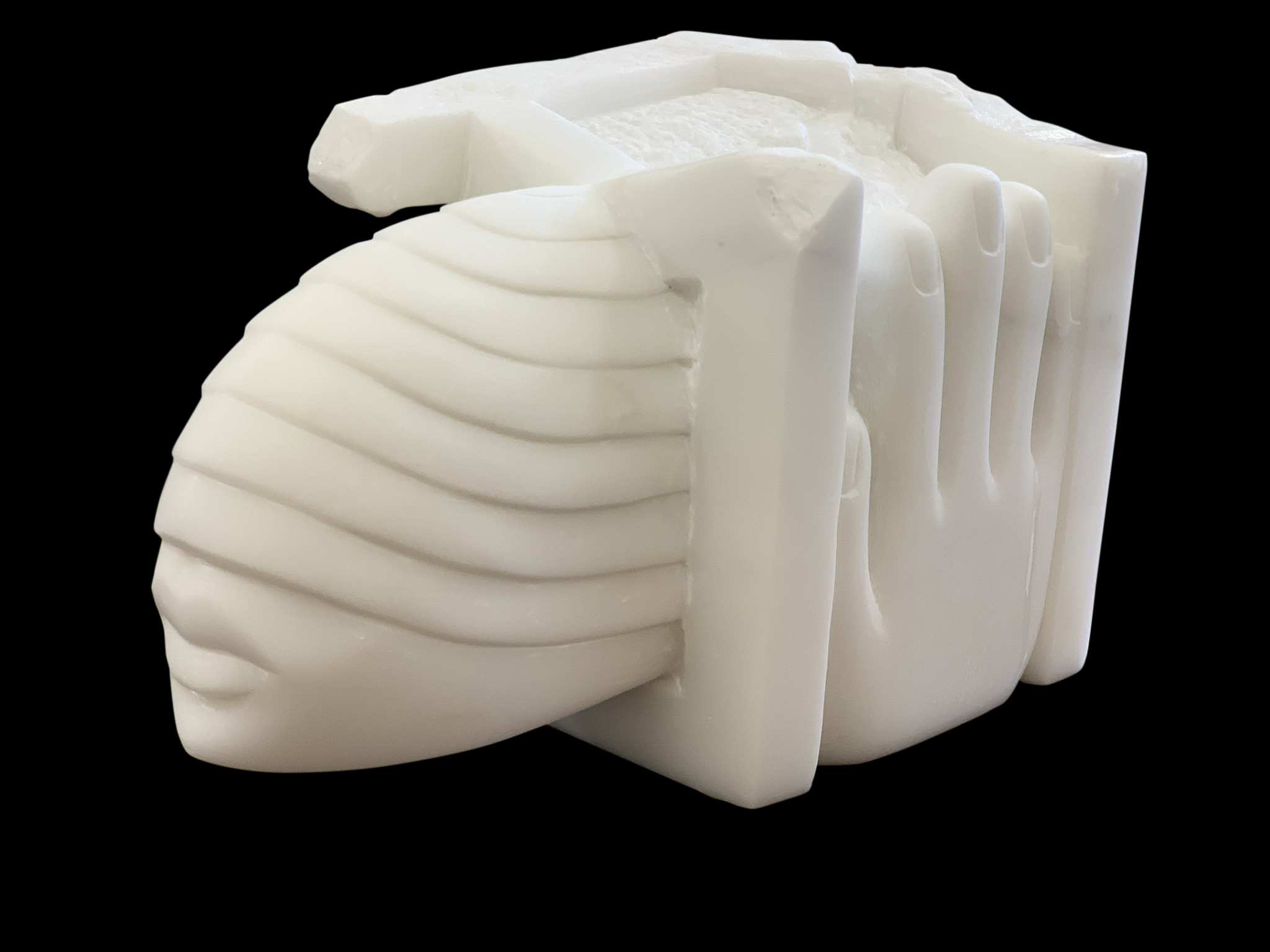






Works in Stone |
||
|
Stone has been, for the most part of history, a fundamental material in the creation of art, architecture and society. Examining ancient civilisations such as the Roman Empire, we can see how the incorporation of stone both in architectural sites, and in art, became an exemplification of wealth and status. The fact that such heritage sites still co-exist alongside today’s society in the Italian capital, highlights the strength and endurance of stone as a material. The natural connection that occurs between humans and the earth, through the incorporation of stone, is indicative of its success and part of the reason for its prevalence in artistic practice today. Looking specifically at the works of Dawn Rowland, Mel Fraser, and Johannes von Stumm, I will explore the poignancy of stone as a primary medium for these three artists. |
||
|
Dawn Rowland (FRSS) is a sculptor whose emotionally charged works offer an insight into the profundity of stone as a material. Rowland’s sculptures are demonstrable of her unquestioning carving skills, with the perfect proportioning giving her work refined edges and with this a sense of authority. Rowland’s use of granite in her two Boxed In sculptures gives a richness and depth to the works. As suggested by the title, the subject is boxed in between four walls with little space for movement. The density of the granite that encompasses the head gives a greater sense of oppressiveness, where one is physically able to imagine the weight being forced down upon their own head. The incorporation of a blindfold, which covers over half of the face, again adds to the severity of the box. The lack of sight could suggest fears of loneliness and desolation, playing into the subconscious fears of the viewer. The carved lines in the blindfold represent the creases and crevices exposed when blindfolds are taut across their wearers’ face, again signifying a sense of forcefulness and overbearing. Such realistic sculptural features depicted by Rowland, allow for a greater connection to be made between viewer and sculpture. Measuring 61 x 61 x 40 cm, Boxed In is commanding in its stature, preventing the onlooker from being able to ignore its presence. Such power commanded by the sculpture in both interior and exterior settings, is in direct juxtaposition of the message being revealed. Rowland talks to our conscience reminding us that, particularly in a time such as the present, we must engage with those around us. The same four walls are becoming an alarmingly overbearing factor in the lives of others. |
Boxed In (Black Granite) |
|
  Boxed In (Black Granite) Breaking Out |
Although smaller in scale (46 x 46 x 32 cm), Dawn Rowland’s Boxed In made with black granite evokes the same emotions from its beholder. The choice of black granite gives a complete sense of inescapability and alienation, driving the viewer to assess their own wellbeing and internal emotions. Similarly to her Boxed In series, Rowland continues to explore the human psyche with her work Breaking Out. Unlike its Boxed In counterparts, Breaking Out (20.5 x 32 x 15 cm) is liberating, with the model forcing their way free from the constraints with which they were initially restricted to. The elongation of the head in Breaking Out displays a sense of force and overcoming of challenge, with the lowered blindfold further strengthening the pull of the model away from their confines. Rowland often depicts hands in her work. Similarly, the hands carved on the side of the subject’s face are illustrative of strength, power and a re-emergence into the world. |
|
|
Mel Fraser’s portfolio, comprised both of abstract and figurative works, often with deeper symbolic meaning. Fraser’s absolute proficiency in carving in alabaster is proven by the challenges she overcomes. Angel Wing XX, is a prime example of this where the top curves of the sculpture have been carved to such an extent, one can see through it. This technique is laden with risk and the high possibility that the alabaster may crack, leaving the work shattered. Fraser’s Eternity III represents the symbol of infinity, in which layers of the circle meet in the middle, overlapping as they go. The historical significance of the infinity symbol from which the idea of eternity is derived, depicts a serpent biting its own tail. In this way it signifies infinite immortality, continuity, self-fertilization and eternal return. Since then, eternity has become an idea fostered by humans in their seeking of familial and romantic relationships. The choice of white alabaster, where white represents purity, again references the pure and eternal bonds we long to pursue with other humans. The smooth curved surfaces suggest consistency and reliability, relating to what we seek from the eternal and our relationships. |
Eternity II Angel Wing XX |
|
|
Mel Fraser’s Gaia, originating from Greek mythology (being a personification of Earth, and a Greek deity, the ancestral mother of all life) introduces the role of stone within sculpture, as a physical link between the natural world, and humanity. By using stone, Fraser immediately connects the viewer back to their ancestral past in which stone is both a source of power and creation. Fraser’s choice to sharpen and then smooth the features of Gaia, whilst leaving the back rough and jagged is suggestive of an emergence from the earth beneath her. The coarse stone surrounding her face likens the original state of the stone before being carved and sanded. Her face, with pouted lips and closed eyes, is serene in its depiction, with the titled head emitting an air of authority and matriarchal status. As the viewer, we feel enticed by Gaia, eager to explore her profound beauty, much like we continue endeavouring to do in our world. Both the universality of stone, and Fraser’s depiction of Gaia remain consistent worldwide, provoking appreciative sentiments from all it encounters. |
|
|
Past President of the Royal Society of Sculptors, and founder of the Sculpture Network (Europe), Johannes von Stumm is an acclaimed international sculptor whose work challenges and defies pre-existing laws of physics with the complex arrangement of his materials joining in harmony. Demonstrable of this is von Stumm’s Four Rectangles, which pieces together Bronze, glass, stainless steel and stone. At the base of the small totem lays hand-blown glass which, placed upon it in a puzzle-like manner is the steel and bronze. Above them, fusing together the already challenging amalgamation of materials, is the stone. This work feels symptomatic of Johannes von Stumm’s life where both glass and steel have deep roots within his ancestral history. The uniting of glass and steel are a direct depiction of the familial ties born from the relationship between his mother and father, with the steel from the blacksmith and steel factory lineage of his father’s side, and his mother’s ancestors owning a glass factory in Bohemia. Whilst introducing this very personal, and deep-rooted connection, von Stumm adds two more conflicting elements; bronze and stone. It is these two materials that are characteristic of the challenges von Stumm faced in his early career, being initially dissuaded from following an artistic path by one of his tutors to then following these exact intuitions he was so vehemently discouraged from doing, and not only making a living from it, but achieving critical acclaim and global success. |
Four Rectangles |
|
|
At that moment of enlightenment that led Johannes von Stumm’s desire to work with these juxtaposing materials to create a whole, he was told such combinations were impossible. However, through considerable determination, von Stumm has now created many sculptures that integrate the variety of materials as Four Rectangles has done, proving such challenges can be overcome. The bronze included references the strength and endurance one must practice for success, whilst the stone epitomises endurance and solidity. The natural phenomenon of stone, being a close tie to the natural world for humans, shows this innate appreciation for the natural world, and our ultimate reliance upon it. Such a simple yet complex combination of materials fosters an awakening within its onlooker, encouraging them to challenge and reassert themselves, even when faced with discouragement. |
||
|
The varying works of these three artists demonstrates the central and spiritual role that stone plays in sculpture, teaching viewers to appreciate the natural beauty that lays before them. The continuous use of stone throughout history to the present day demonstrates its beguiling power over humans, and the versatility of stone means that there is always more to explore. |
||